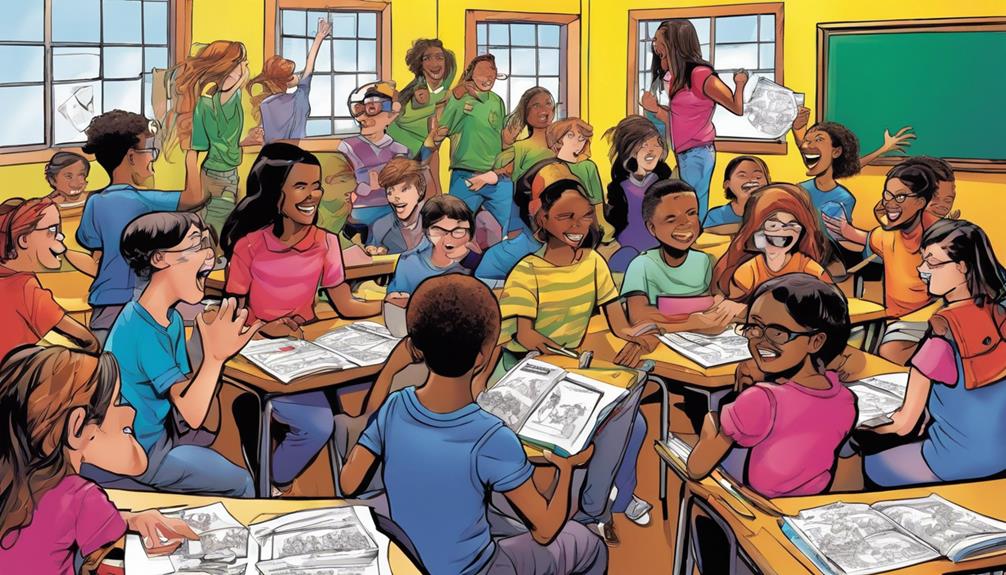In romantic relationships, **communication barriers** may strain bonds, yet one can overcome them. Recognizing different communication styles and appreciating non-verbal cues is key. Patience and empathy help tackle emotional barriers shaped by past experiences. Reflecting on beliefs and expectations keeps them realistic and fair. **Trust** flourishes when setting safe boundaries for physical and emotional interactions. **Active listening** by reflecting and validating a partner’s feelings fosters deeper understanding and intimacy. Take these steps for a deeper connection.
Key Takeaways
- Practice active listening by giving full attention and reflecting back emotions to ensure understanding.
- Address and manage emotional triggers collaboratively to maintain a safe and trusting environment.
- Respect cultural differences and adjust communication styles to foster inclusivity and understanding.
- Set clear physical and emotional boundaries to ensure both partners feel safe and respected.
- Encourage open and honest dialogue to clarify misunderstandings and align expectations.
Identifying Communication Barriers

Let's explore the common barriers that can disrupt open communication in our romantic relationships.
One significant barrier is differences in communication styles. When we and our partner have different ways of expressing ourselves, misunderstandings can easily arise. For instance, one of us might be more direct while the other tends to be more passive, leading to a feeling of being misunderstood. These mismatched styles can create a gap in understanding, making it harder to connect on a deeper level.
Non-verbal communication also plays an important role in how we interact with each other. Our body language, facial expressions, and even our tone of voice can send powerful messages. If these non-verbal cues are misinterpreted, they can become barriers to effective communication. Imagine trying to discuss something important, only for our partner to misread our tone as annoyed or disinterested. It can quickly escalate into frustration and further misunderstandings.
Additionally, cultural differences or language barriers can complicate our interactions. When we come from different backgrounds, our expectations and ways of expressing love mightn't align, leading to confusion and conflict. Understanding these barriers helps us navigate and improve our communication with our partner.
Emotional Barriers

While communication styles and non-verbal cues can create obstacles, emotional barriers often pose even greater challenges in romantic relationships. Many of us carry emotional baggage from past experiences or unresolved issues, which can make it difficult to express our feelings or connect emotionally with our partners. These emotional barriers can feel significant at times.
However, addressing emotional barriers requires vulnerability, empathy, and understanding between partners. By developing effective communication skills, such as active listening and emotional validation, we can start to break down these walls.
Active listening means truly hearing what our partner is saying without immediately jumping to conclusions or responses. It allows us to understand their emotions and experiences better.
Moreover, emotional validation is important; it helps our partners feel seen and heard, fostering a sense of safety in the relationship. Sometimes, professional help is needed. Seeking therapy or counseling can provide a safe space for both partners to explore their emotions and learn better communication techniques.
Therapy can help us navigate through our emotional barriers, bringing us closer and strengthening our relationship. Remember, overcoming emotional barriers is a journey, but with patience and effort, it's entirely possible.
Communication Styles

Let's explore how we communicate with our partners, focusing on verbal vs. nonverbal cues, active listening techniques, and emotional expression styles.
By understanding these aspects, we can enhance our connection and address any misunderstandings effectively.
Together, we can create a space where both partners feel heard and valued.
Verbal Vs. Nonverbal Cues
In romantic relationships, we often find that nonverbal cues, such as eye contact and body language, speak louder than words. While verbal cues—our spoken words and language—are essential for conveying specific information, nonverbal cues play an equally significant role in how we communicate. Research even suggests that over 90% of our communication is nonverbal.
When our verbal and nonverbal cues don't align, communication barriers arise. For example, saying 'I'm fine' with crossed arms and averted eyes can create misunderstandings. Our body language, gestures, and facial expressions often convey our true emotions more powerfully than words alone. Misunderstandings can easily happen if we ignore these nonverbal signals or if they contradict what's being said verbally.
To overcome these barriers, we need to pay attention to both verbal and nonverbal cues. Eye contact, posture, and tone of voice can provide deeper insights into our partner's feelings and attitudes. Recognizing these signals helps us connect on a more profound level, fostering trust and intimacy.
Active Listening Techniques
Active listening techniques are essential for fostering deeper understanding and connection in romantic relationships. When we truly listen to our partners, we show that we value, respect, and care about their thoughts and feelings. This doesn't just help us understand them better; it also builds empathy and a stronger emotional connection.
Practicing active listening can help prevent misunderstandings and conflicts. Here are some techniques we can use:
- Paraphrasing: Restate what our partner has said in our own words to show we're paying attention and to clarify understanding.
- Summarizing: Give a brief overview of the main points to confirm we've grasped the essence of their message.
- Reflecting: Mirror our partner's emotions by acknowledging their feelings, which helps them feel heard and understood.
- Asking clarifying questions: Pose questions to clear up any confusion and make sure we fully comprehend their perspective.
Emotional Expression Styles
We all express our emotions differently, and understanding these unique styles can greatly enhance communication in romantic relationships. Emotional expression styles like direct, indirect, avoidant, and open ways of conveying feelings play an important role in how we connect with our partners.
Recognizing these styles helps us navigate communication barriers and better understand our partners' feelings.
Some of us are direct, openly sharing our emotions without hesitation. Others might adopt an indirect approach, hinting at how they feel rather than stating it outright. There are also those who avoid discussing emotions, finding it uncomfortable or challenging.
On the other hand, some are entirely open, freely expressing their feelings without restraint. Each style has its own strengths and challenges, and understanding them allows us to foster a healthier relationship.
Beliefs and Expectations

Rigid beliefs and unrealistic expectations often trip us up in romantic relationships, stifling open communication and mutual understanding. When we hold rigid beliefs, we limit our ability to see things from our partner's perspective, which can hinder open communication.
Unrealistic expectations, on the other hand, place undue pressure on our conversations, making it hard to communicate effectively.
To foster a healthier dynamic, we need to understand and address our beliefs and expectations.
Here's how:
- Examine our beliefs: Reflect on what we believe about love, partnership, and communication, and consider how these beliefs shape our interactions.
- Manage our expectations: Be realistic about what we expect from our partners, making room for human error and individual differences.
- Focus on open communication: Share our thoughts and feelings openly, listening actively without preconceived ideas.
- Cultivate mutual respect: Recognize and value each other's viewpoints, fostering an environment of mutual respect.
Physical and Emotional Safety

When it comes to nurturing a healthy romantic relationship, establishing trust boundaries is essential for both physical and emotional safety. We need to address emotional triggers that might make our partners feel unsafe, and practice active listening to show that we genuinely care about their feelings.
Establish Trust Boundaries
Establishing trust boundaries in a relationship involves clearly communicating our needs for both physical and emotional safety. When we openly discuss these needs, we create a safe environment where both partners can express their thoughts and feelings without fear of judgment or harm. This foundation of trust is essential for overcoming communication barriers and fostering a deeper connection.
To establish these boundaries, we should focus on:
- Physical safety: Setting limits on physical interactions and respecting each other's personal space.
- Emotional safety: Ensuring that our conversations are respectful, and that we're sensitive to each other's feelings.
- Open communication: Encouraging honest dialogue about our needs and expectations, without resorting to blame or criticism.
- Established boundaries: Clearly defining what's acceptable and what isn't, helping to prevent misunderstandings.
Address Emotional Triggers
Recognizing and addressing emotional triggers in our relationship is essential for maintaining both physical and emotional safety. When we comprehend what sets off our emotional responses, we can better navigate the communication barriers that often arise in romantic relationships. Identifying these triggers allows us to approach sensitive topics with more empathy and caution, ensuring that both partners feel respected and heard.
Creating a safe space for open dialogue is vital for tackling emotional triggers. When we prioritize emotional safety, we foster an environment where we can express our feelings authentically without the fear of judgment or harm. This safe space encourages honest communication, helping us to understand each other's needs and perspectives more deeply.
By working together to address emotional triggers, we can build healthier and more fulfilling romantic connections. This collaborative approach not only strengthens our bond but also helps us to support each other through difficult emotions and situations. Open dialogue paves the way for mutual understanding and trust, essential components of a successful relationship.
Let's remember that addressing emotional triggers isn't a one-time task but an ongoing process. By continuously creating a safe space for each other, we can overcome communication barriers and nurture a loving, supportive relationship.
Practice Active Listening
How can we genuinely connect with our partners if we don't practice active listening?
Active listening involves more than just hearing; it's about truly understanding our partner's words and emotions.
When we focus on both their verbal and non-verbal cues, we break down communication barriers and foster a deeper sense of trust and intimacy.
To practice active listening, we need to:
- Give our full attention: Put away distractions like phones or TVs to show our partner we value their words.
- Reflect and validate: Paraphrase what our partner says to make sure we've understood, and acknowledge their feelings.
- Ask open-ended questions: Encourage deeper conversation by asking questions that require more than a yes or no answer.
- Be patient and empathetic: Allow our partner to express themselves without interrupting, showing that we genuinely care.
Active Listening Techniques

To truly connect with our partners, we need to practice active listening by giving them our full attention and engaging with their words. When we focus on active listening, we break down communication barriers and foster a deeper understanding. This means not just hearing the words but also picking up on the non-verbal cues like eye contact, nodding, and mirroring their body language. These small actions show empathy and genuine interest in what our partner is sharing.
Active listening involves several key techniques. First, we should paraphrase what our partner has said, ensuring we've understood their message correctly. For example, we might say, 'So, what you're feeling is…' This shows that we're truly engaged.
Summarizing is another powerful tool, where we condense their main points to confirm our understanding. Reflecting back emotions can also make a significant difference, such as saying, 'It sounds like you're really frustrated about this situation.'
Improving Understanding and Connection

Building on the foundation of active listening, we can further improve our understanding and connection by addressing emotional barriers and refining our communication skills. Emotional barriers like fear and insecurity can undermine our ability to connect deeply with our partners. By acknowledging and addressing these feelings, we create a safer space for open dialogue.
To enhance our communication, we can focus on:
- Verbal communication issues: Clarify misunderstandings promptly to prevent misinterpretations.
- Non-verbal cues: Pay attention to body language, facial expressions, and tone of voice, which convey much more than words alone.
- Cultural differences: Respect and understand varying communication styles, fostering a more inclusive connection.
- Digital communication: Limit information overload by prioritizing meaningful interactions over constant digital chatter.
Understanding and overcoming these barriers helps us build a stronger emotional connection. When we pay attention to our partner's non-verbal cues, we gain insight into their true feelings, which often go unspoken. Addressing verbal communication issues with empathy allows us to resolve conflicts more effectively. By respecting cultural differences, we can navigate perceptual barriers with greater ease. Lastly, focusing on quality over quantity in digital communication strengthens our bond, making every interaction count.
Together, we can create a supportive and loving relationship.
Frequently Asked Questions
How Can We Maintain Effective Communication During Long-Distance Relationships?
To maintain effective communication during long-distance relationships, we need to prioritize regular check-ins, like video calls or texting, to stay connected.
It's important to be honest about our feelings, even when it's tough. We should also plan visits whenever possible and share little daily moments, like photos or voice messages.
What Role Does Technology Play in Enhancing or Hindering Romantic Communication?
We might worry that technology creates distance, but it also lets us stay connected. Video calls, texts, and social media help us share moments, bridging gaps between us.
Sure, misunderstandings can happen, but we can overcome them by being patient and clear. Technology, when used thoughtfully, enhances our connection, making us feel closer even when we're miles apart.
Let's embrace its potential to strengthen our bonds.
How Do Cultural Differences Impact Communication in Romantic Relationships?
Understanding cultural differences can deeply impact communication in romantic relationships. When we come from diverse backgrounds, our values, traditions, and communication styles might clash.
Embracing these differences with empathy, patience, and openness is crucial. By actively listening and showing respect for each other's cultures, we create a stronger bond.
We can navigate misunderstandings together, turning potential conflicts into opportunities for growth and deeper connection.
Can Professional Counseling Help Improve Communication in Relationships?
Yes, professional counseling can definitely help improve communication in relationships.
By providing a safe space, counselors guide us to express our feelings openly, understand each other's perspectives, and learn effective communication strategies.
It's not just about talking more; it's about talking better.
With a counselor's help, we can break down barriers, rebuild trust, and create a deeper, more fulfilling connection with our partners.
What Are Some Fun Activities to Strengthen Communication Between Partners?
Let's try some fun activities to strengthen our communication. We can play board games that require teamwork or take a cooking class together. These activities help us bond and practice clear, open dialogue.
Another great option is to engage in trust-building exercises, like tandem biking or partner yoga. These experiences create opportunities for us to listen, understand, and connect on a deeper level, enhancing our relationship.
Conclusion
Let's remember, breaking down communication barriers in our romantic relationships is like tending a garden.
We need to pull out the weeds of misunderstandings and plant seeds of active listening and empathy.
By recognizing emotional barriers and aligning our communication styles, we create a safe space for love to flourish.
Together, we can nurture our connections, ensuring they grow stronger and more resilient, just like a well-tended garden bursting with life and color.











